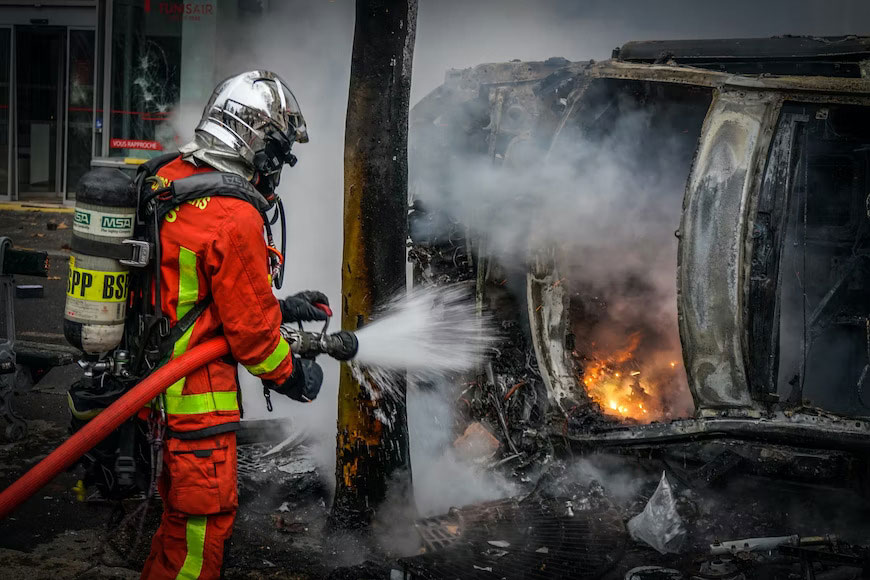Table of Contents
Firefighters are true heroes, fearlessly confronting flames to protect lives and property. However, the very tools they employ to extinguish fires have given rise to a lesser-known battle. Toxic firefighting chemicals pose significant health risks to these courageous individuals.
In an article published by NBC News in August 2022, it was reported that the firefighters union has previously cautioned its members about potential health hazards associated with their firefighting equipment. The warning emphasized that the equipment contains per- and polyfluoroalkyl substances (PFAS), which are artificial substances known to be linked to various health problems, such as an elevated likelihood of developing liver and kidney cancer.

In this article, we will explore the ongoing fight against these firefighting chemicals, highlighting the efforts to protect firefighters from their harmful effects.
The Silent Hazards of Firefighting Chemicals
Firefighters have long been hailed as heroes for their bravery and dedication to saving lives and property from the ravages of fire. However, the very chemicals they rely on to extinguish flames can pose serious health risks.
Firefighting chemicals, such as perfluorooctanoic acid (PFOA) and perfluorooctane sulfonate (PFOS), have been linked to various health issues, including cancer, thyroid disorders, and reproductive problems. Despite their firefighting prowess, firefighters face silent hazards that can impact their long-term well-being.
Also Read: Why Should You Consider Buying Steel Storage Units?
The Origins of Firefighting Chemicals
PFOA and PFOS, commonly found in firefighting foams and gear, belong to the previously discussed group of chemicals known as PFAS. These chemicals were initially developed for their ability to repel water, grease, and oil.
As a result, they gained widespread use in various industries, including firefighting, due to their effectiveness in suppressing flammable liquid fires. However, their widespread usage has led to their presence in the environment, including soil, water sources, and even the bodies of humans and wildlife.
The Centers for Disease Control and Prevention emphasized in a recent statement that PFAS persists in the environment and can lead to human exposure when individuals consume water or food contaminated with PFAS.
The Health Risks Faced by Firefighters
Firefighters are at a heightened risk of exposure to firefighting chemicals due to their occupational nature. When extinguishing fires, firefighters make use of AFFF (Aqueous Film-Forming Foam), which contains PFAS. Prolonged exposure to AFFF can lead to bioaccumulation of PFAS-laden particles within their bodies over time.
Despite taking precautions such as wearing personal protective equipment (PPE), firefighters still face the challenge of combating the insidious health risks posed by these chemicals. This has even led to a number of affected firefighters filing an AFFF lawsuit against manufacturers of firefighting foam, alleging that they were not adequately warned about the potential dangers associated with PFAS exposure.
According to TorHoerman Law, these lawsuits aim to seek compensation for the physical and emotional toll these firefighters have endured. They also note that in order to increase the chances of obtaining a maximum settlement, it is important to seek the guidance of an experienced personal injury lawyer who specializes in handling such sensitive cases.
Efforts to Reduce Firefighter Exposure
Recognizing the dangers of firefighting chemicals, efforts have been made to reduce firefighter exposure to PFAS. Many fire departments have shifted to using alternative firefighting foams and gear that are free from PFAS or have lower PFAS content.
Moreover, stricter regulations and guidelines are being implemented to control the use and disposal of PFAS-containing products. According to an article in Environmental Health News, Washington became the first state to prohibit the use of PFAS-containing foams in most firefighting applications in 2018. Several additional states have passed similar measures since then.
Additionally, research is ongoing to develop safer and more effective alternatives that can mitigate the risks while maintaining firefighting capabilities.
Advocacy and Support for Firefighters
Various organizations and advocacy groups are working tirelessly to raise awareness about the health risks faced by firefighters and push for better protection and support. These groups provide resources and education to firefighters, ensuring they are equipped with the knowledge to minimize exposure and take preventive measures.
They also advocate for legislative changes to regulate and phase out the use of harmful firefighting chemicals. Additionally, healthcare initiatives and support programs are being established to address the unique healthcare needs of firefighters and provide access to specialized medical care.
Also Read: Tips To Select Cabinet Handles And Knobs
Final Thoughts
The struggle against firefighting chemicals and their negative effects on firefighters is a continuing and important topic. Toxic compounds such as PFAS found in firefighting equipment and foams offer severe health hazards to these heroic individuals, including an increased chance of acquiring cancer and other catastrophic illnesses.
Efforts are ongoing to safeguard firefighters from these hidden threats, including the use of alternate firefighting foams and gear with low or no PFAS concentration. Stricter rules and lobbying initiatives are also assisting in raising awareness and advocating for improved protection and support for firemen.
Overall, ongoing research and innovation are critical in developing safer alternatives that preserve strong firefighting capabilities while protecting the health and safety of people on the front lines.







